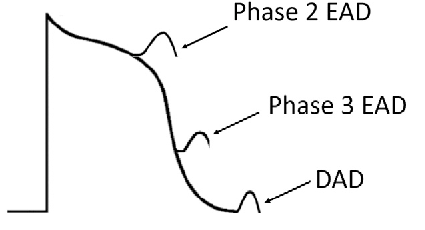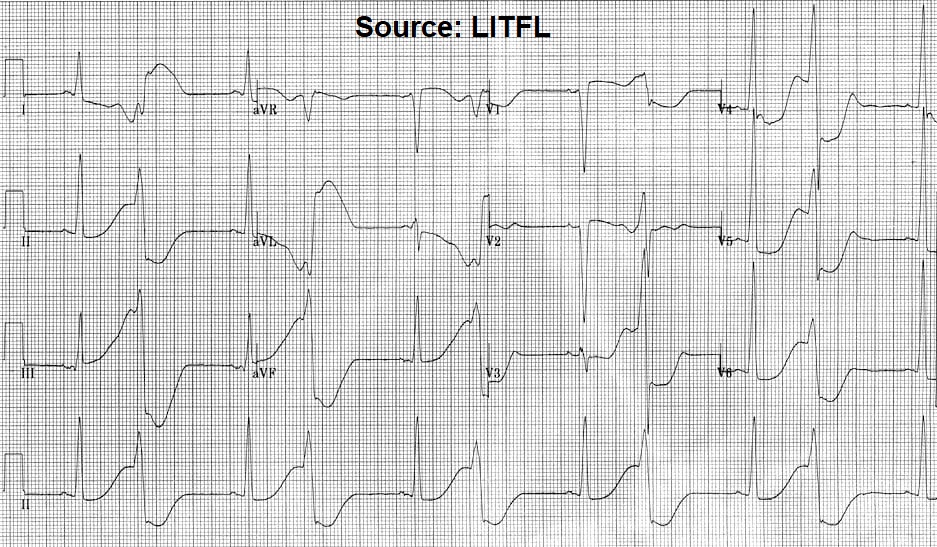1/ *Can We See Torsades...

Highlights
- 1/ Can we see Torsades coming?
A few months ago, I had the chance to study the rhythm changes leading up to an episode of Torsades. Discussed here -
https://t.co/nddhsIAcD4
This helped me pick up some "warning signs" that may help facilitate early recognition.
#tweetorial (View Tweet)
- 2/There are 3 critical substrates for Torsades:
(i) Prolonged action potential (long QT)
(ii) Early afterdepolarizations (EAD)
(iii) Dispersion of repolarization (DR)
(i)A long QT is essential but not sufficient. E.g. Amiodarone prolongs QT but reduces DR - low risk of Torsades. (View Tweet)
- 3/ (ii) EAD = depolorization during phase 2/3. In long QT, a longer phase 2 period increases the chances of EADs. However, not every long QT develops EAD so other mechanisms may be involved.
(iii) DR = heterogenous repolarization properties within the myocardium: PMID: 16253930.
 (View Tweet)
(View Tweet)
- 4/ Although torsades is "initiated" by EADs, it is likely "maintained" by reentry mechanisms facilitated by DR.
Now let's focus on EADs. They are responsible for the "R" in the "R-on-T". They are also likely responsible for some of the EKG changes leading up to Torsades. (View Tweet)
- 5/ Again, EADs don't always result in Torsades (if not followed by reentry). Importantly, their electrical effects can be picked up on a surface EKG. The pattern of EKG findings depend on whether the EAD was propagated (technical term = triggered activity) or not. (View Tweet)
- 6/ (i) EAD not propagated - this would result in repolarization abnormalities - the giant T-U wave (T and U waves are often fused and difficult to distinguish).
This has been systematically studied: PMID: 19573731. Abnormal T-U waves directly preceded Torsades in 34/35 patients!
 (View Tweet)
(View Tweet)
- 7/(ii) If the EAD is propagated -this would result in a PVC right after the giant T-U wave
PVCs are usually accompanied by ST-T aberrancies (just like bundle branch blocks). However, you combine this with EADs and it results in "bizarre" ST-T changes.
Example from that article
 (View Tweet)
(View Tweet)
- 8/ Importantly, since EAD is facilitated by longer action potential duration (APD), the amplitude of the 'post-pause' EADs would be higher.
This can happen when a PAC/PVC resets the sinus node and the next sinus beat is delayed. This delayed beat will have a longer APD.
 (View Tweet)
(View Tweet)
- 9/ If the amplitude of the post-pause EAD is high enough, it may propagate and cause a PVC. This PVC will reset the sinus node and cause another pause and so on.
This produces a bigeminal pattern called "short-long sequence", the initiation of which was demonstrated in our case.

 (View Tweet)
(View Tweet)
- 10/ When you see this pattern, Torsades is absolutely imminent.
Found a similar example on LITFL - https://t.co/ttnhCq0lbX
A few weeks later I had saw this pattern again in a patient who was started on scheduled Reglan. 2 g Mag over 10 minutes resulted in obvious improvement.
 (View Tweet)
(View Tweet)
- 11/ I have no doubt in my mind that patient would have had Torsades had I not administered the Mag.
Side-note -
It's also important to not confuse this pattern with ischemia. Although the PVCs may have discordant ST changes, careful assessment of the sinus beats will be helpful. (View Tweet)
- 12/ Summary:
(i) As telemetry is ubiquitous in the ICU, an astute pair of eyes may be able to 'see Torsades coming'
(ii) Pattern-recognition: Giant T-U waves (especially post-pause) +/- "bizarre" bigeminy
(iii) Once you see this, determine the QT/U. If prolonged start treatment! (View Tweet)
- 13/ Treatment of Torsades deserves a separate discussion but some key points can be found here -
https://t.co/NSyn3JfMBK
https://t.co/ZSR6RsM8rI
Feel free to spread the word! (View Tweet)

 (View Tweet)
(View Tweet) (View Tweet)
(View Tweet) (View Tweet)
(View Tweet) (View Tweet)
(View Tweet)
 (View Tweet)
(View Tweet) (View Tweet)
(View Tweet)